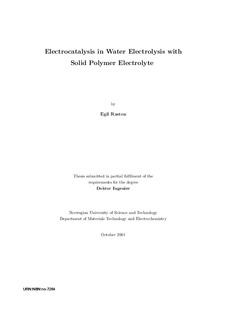Electrocatalysis in water electrolysis with solid polymerelectrolyte
Doctoral thesis
Permanent lenke
http://hdl.handle.net/11250/244448Utgivelsesdato
2001Metadata
Vis full innførselSamlinger
Sammendrag
Development and optimization of the electrodes in a water electrolysis system using a polymer membrane as electrolyte have been carried out in this work. A cell voltage of 1.59 V (energy consumption of about 3.8 kWh/Nm3 H2) has been obtained at practical operation conditions of the electrolysis cell (10 kA ·m−2, 90 ◦C) using a total noble metal loading of less than 2.4 mg·cm−2 and a Nafion ® -115 membrane. It is further shown that a cell voltage of less than 1.5 V is possible at the same conditions by combination of the best electrodes obtained in this work.
The most important limitation of the electrolysis system using polymer membrane as electrolyte has proven to be the electrical conductivity of the catalysts due to the porous backing/current collector system, which increases the length of the current path and decreases the cross section compared to the apparent one. A careful compromise must therefore be obtained between electrical conductivity and active surface area, which can be taylored by preparation and annealing conditions of the metal oxide catalysts.
Anode catalysts of different properties have been developed. The mixed oxide of Ir-Ta (85 mole% Ir) was found to exhibit highest voltage efficiency at a current density of 10 kA · m−2 or below, whereas the mixed oxide of Ir and Ru (60-80 mole% Ir) was found to give the highest voltage efficiency for current densities of above 10 kA · m−2.
Pt on carbon particles, was found to be less suitable as cathode catalyst in water electrolysis. The large carbon particles introduced an unnecessary porosity into the catalytic layer, which resulted in a high ohmic drop. Much better voltage efficiency was obtained by using Pt-black as cathode catalyst, which showed a far better electrical conductivity.
Ru-oxide as cathode catalyst in water electrolysis systems using a polymer electrolyte was not found to be of particular interest due to insufficient electrochemical activity and too low electrical conductivity.
